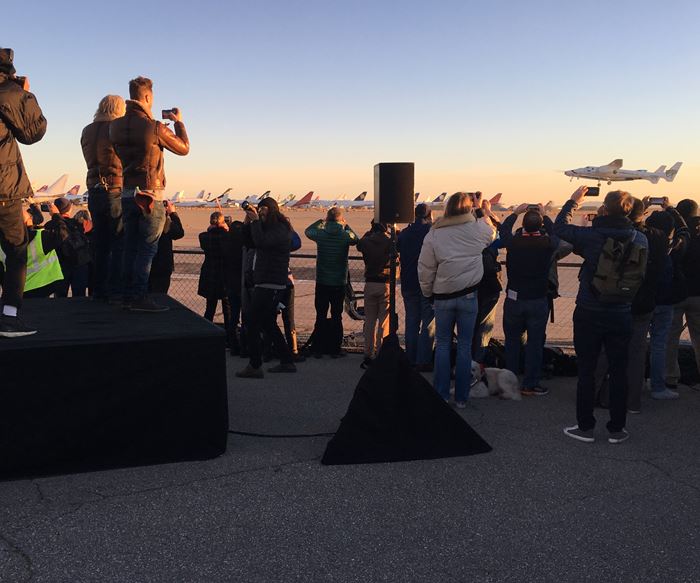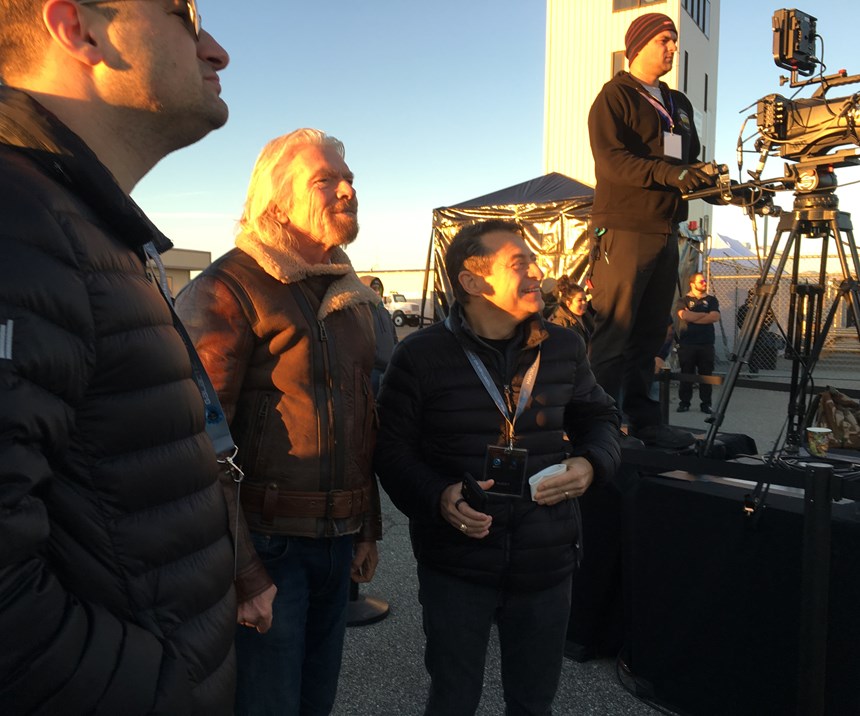One step closer to commercial spaceflight
CW senior writer emeritus Donna Dawson provides an eyewitness account of the launch and safe return to Earth of Virgin Galactic’s SpaceShipTwo on the day of its first spaceflight.
Today I had the privilege of being among about 500 eager people gathered in the early winter cold of the Mojave desert in California to watch the launch of SpaceShipTwo (SS2) by The Spaceship Company (TSC, Mojave, CA, US), a part of Virgin Galactic (VG, London, UK). (See the December CW story, “Leveraging composites for space tourism”).
TSC President Enrico Palermo and VG founder Richard Branson shared the stage as they expressed their hope and confidence in a smooth and successful launch. And that’s what it turned out to be.
Takeoff was about 7 a.m. With SS2, called Unity, firmly attached between the twin fuselages of the WhiteKnightTwo (WK2) carrier aircraft, or mother ship as it’s known, the pair rolled down the runway and lifted off, looking smooth and steady as they rose together into a clear, cloudless sky. The crowd watched the pair for awhile, and then WK2’s contrails, and then lost sight of it in the northern sky.
Palermo reported WK2 made a U-turn at about 40,000 ft and at 43,000 ft (>8 miles) SS2 released from WK2 — a simple pneumatic release actuated by WK2’s pilots – and dropped below its carrier.
SS2 pilots Mark (Forger) Stucky and C.J. Sturckow ignited Unity’s rocket and the craft shot very fast straight up toward space — a boost that reached 2.9 Mach. After a 60 second burn, Unity continued to its apogee of 271,270 ft, or 52.4 miles, , to near space, out of Earth’s atmosphere, high enough to see the turn of the Earth below and feel the effects of weightlessness. NASA defines space as beginning 50 miles above Earth’s surface (above sea level).
When SS2 was just below its highest destination—the 52.4 mile apogee—the pilots pneumatically actuated the feather to its folded-up position, from 0° to 90°. The feather is part of each wing structure and attached to it. The feather was deployed at about Mach 2, imposing a tremendous load on the composite structure of the SS2, which apparently handled it very well.
With its feather in position, the ship returned back into Earth’s atmosphere and glided, without power, back toward Mojave and the runway, under the control of the pilots, passing Mach 2 at 200,000 ft, Mac 2.5 at 140,000 ft with good control, Mach 1.5 at 100,000 ft, still stable at 70,000 ft. At about 55,000 ft, the pilots returned the feathers to their down and locked position for gliding the rest of the way down and through a 360° roll and other test maneuvers for flight test data. We were able to see some of this, as the sun glanced off the silver and blue ship. Finally the gear was locked down for landing.
SS2 landed on the runway at the designed site, rolled toward us and stopped directly in front of the stage to huge applause. Shortly the pilots appeared and approached the crowd to great cheers and hugs from family, and then took the stage to talk to us. Forger Stucky reported the everything went smoothly and the feathering, reaction and control were all great. C.J. Sturckow said only that he “can’t wait to do it again!”
WK2 made its appearance again a few minutes later in a fly-by, again with a steady, stable appearance on its own. Branson pointed out that WK2 — named Eve after his mother — is the largest composite aircraft in flight today.
Richard Branson has announced he plans to fly to space hopefully sometime next year, out of the Spaceport America facility near Las Cruces, NM, US. Further flight and ground tests will be conducted to ensure the safety of the venture. Anticipating a major market for tourism in space, TSC has further spaceships in construction, and a new WhiteKnight is currently in design.
Related Content
Composites manufacturing for general aviation aircraft
General aviation, certified and experimental, has increasingly embraced composites over the decades, a path further driven by leveraged innovation in materials and processes and the evolving AAM market.
Read MoreTU Munich develops cuboidal conformable tanks using carbon fiber composites for increased hydrogen storage
Flat tank enabling standard platform for BEV and FCEV uses thermoplastic and thermoset composites, overwrapped skeleton design in pursuit of 25% more H2 storage.
Read MorePEEK vs. PEKK vs. PAEK and continuous compression molding
Suppliers of thermoplastics and carbon fiber chime in regarding PEEK vs. PEKK, and now PAEK, as well as in-situ consolidation — the supply chain for thermoplastic tape composites continues to evolve.
Read MoreInfinite Composites: Type V tanks for space, hydrogen, automotive and more
After a decade of proving its linerless, weight-saving composite tanks with NASA and more than 30 aerospace companies, this CryoSphere pioneer is scaling for growth in commercial space and sustainable transportation on Earth.
Read MoreRead Next
Plant tour: Daher Shap’in TechCenter and composites production plant, Saint-Aignan-de-Grandlieu, France
Co-located R&D and production advance OOA thermosets, thermoplastics, welding, recycling and digital technologies for faster processing and certification of lighter, more sustainable composites.
Read MoreVIDEO: High-volume processing for fiberglass components
Cannon Ergos, a company specializing in high-ton presses and equipment for composites fabrication and plastics processing, displayed automotive and industrial components at CAMX 2024.
Read More“Structured air” TPS safeguards composite structures
Powered by an 85% air/15% pure polyimide aerogel, Blueshift’s novel material system protects structures during transient thermal events from -200°C to beyond 2400°C for rockets, battery boxes and more.
Read More
















.jpg;maxWidth=300;quality=90)







